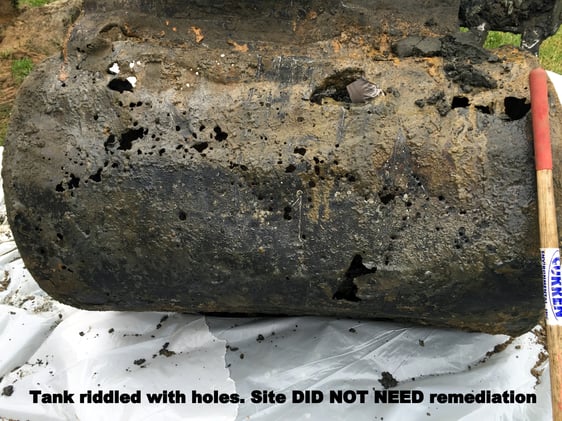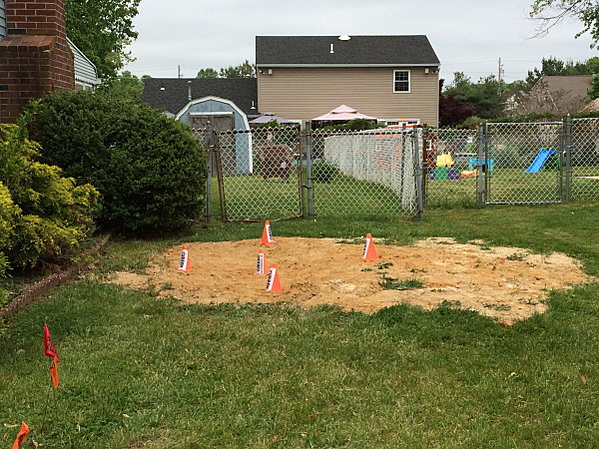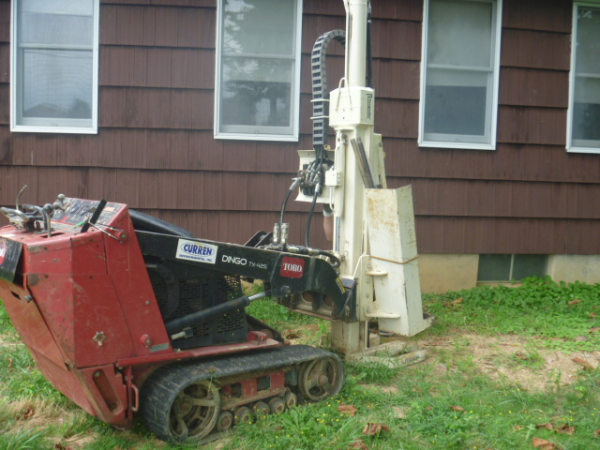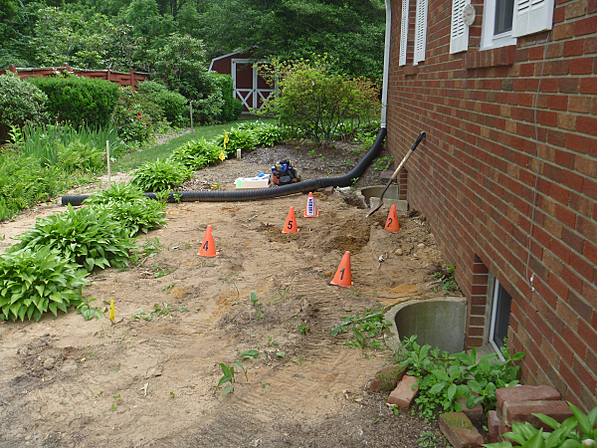My Oil Tank Leaked, What Do I Do Now?
Do you have an oil tank that was removed? Were you told that the tank leaked? Were there no obvious sign of oil? Were there small pin holes in the tank? Were you told that the oil tank cleanup will cost $10,000.00 to $15,000.00. If you answered yes to any of these questions, you need a professional second opinion about your leaking oil tank. 80% of the callers we get that answer yes to every question we have found do not need remediation.

If your oil tank was removed and you have have no soil sample laboratory data with the Petroleum level in the soil (EPH or Extractable Petroleum Hydrocarbons) then you do not know if the tank leak requires remediation. The NJDEP allows a limited amount of oil to remain from a leaking tank if the levels are within the specified range and can also pass two additional analysis.

The above photos shows an area where an oil tank was removed. The sandy fill encompasses the tank grave. Five soil borings were advanced within the tank grave (four sidewall borings and 1 center boring). The boring locations are represented by the orange cones.
The NJDEP allows EPH (Extractable Petroleum Hydrocarbon) levels above 1000 ppm but below 5100 ppm to remain in place if certain criteria and site specific factors are right. Based on the EPH levels found in the tank excavation testing can be performed to present a case that although petroleum levels are present in soils, the petroleum compounds will not leach out from the soils.
<1000 ppm for EPH: No remedial action required
1000 to 5100 ppm EPH, contingent Naphthalene (6ppm maximum allowable) & 2-Methylnapthalene (5ppm maximum allowable). If samples exceed for either compound, Synthetic Precipitation Leachate Procedure (SPLP) analysis required, results to be below 390 ug/L
>5100 ppm EPH: Soil remediation is required.
* samples must be stored at 4 to 2 degrees Celsius until analyzed. Samples must be extracted within 14 days and extracts must be analyzed within 40 days of extraction.

If you want to evaluate a removed tank location to determine if the tank leak occurred to the extent that remediation is warranted, you would acquire samples from the former tank area. To thoroughly a tank excavation all your borings must be INSIDE the area. For a 500 gallon tank location, you would advance soil borings within a rectangle size area measuring 5.5" by 48" wide. To Compliance Sample your former tank excavation, you must not have any EPH levels above 5100 ppm and you must obtain additional samples from the tank area to confirm that all EPH levels are below 5100 ppm. In essence you are obtaining soil samples from the four sidewalls of the tank grave, as well as deeper samples to prove that the tank release was small and petroleum levels are within permissible concentrations. If these samples (typically five to six soil samples) are within standard, then Curren Environmental can submit a report to the NJDEP asking for closure. This is what is called an NJDEP UHOT (Unregulated Heating Oil Tank) submission. The submission includes a detailed report of the procedures followed to investigate a removed tank location as well an an NJDEP UHOT questionnaire. The report and questionnaire are submitted to the NJDEP with a $400.00 review fee ($400.00 fee is made payable Treasurer State of New Jersey). Upon the NJDEP's review of the submission, the property owner will receive a No Further Action (NFA) letter for the tank leak, which closes the tank leak out as an issue as it provides approval from the NJDEP that the site is in compliance with the applicable environmental regulations pertaining to the tank.

Compliance sampling a removed tank location is significantly less expensive than performing remediation (contaminated soil removal). The above site was compliance sampling for roughly a 1/4 the estimate that was provided to remediate. If you feel that something is not quote right after your tank is removed, there probable is something wrong. Many people will never remove an oil tank, less will remove a tank that they are told leaked. So this is a once in a lifetime decision few people have to make, what are the odds you are going to get it right and the company directing you is working in your best interest?
If you answer yes to any of the following, let Curren give you a 2nd opinion.
- The tank removal quote you went with was the cheapest or the most LOCAL company.
- The tank removal contract did not include a cost to collect soil samples and/or the contract did not explain what the test data would mean.
- You are removing the tank as part of a real estate transaction so time is of the essence and the tank removal knows it.
- The company said the tank leak is obvious, it would be a waste of money to take any soil samples to confirm the contamination.
- You were offered a quote (guess) to remediate the tank leak, within a week of removal, but were not given a cost to define or delineate the supposed contamination?
Yes to all or any of these questions, should give you pause. If you want more information, click the following link.


